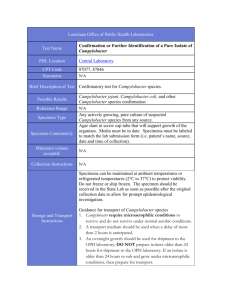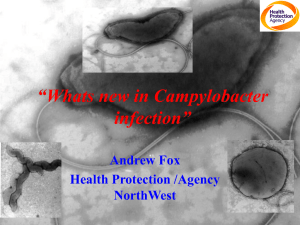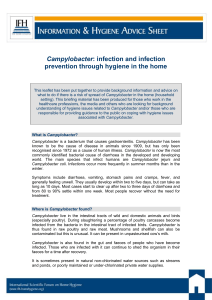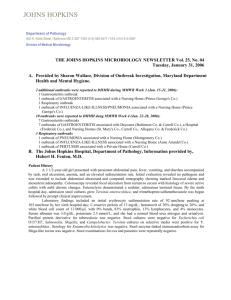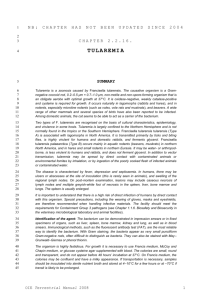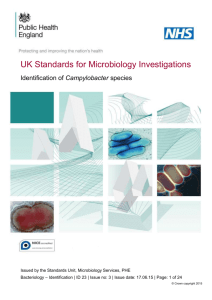Yersinia,FRANCISELLA,PASTEURELLA,VIBRIO, CAMPYLOBACTER
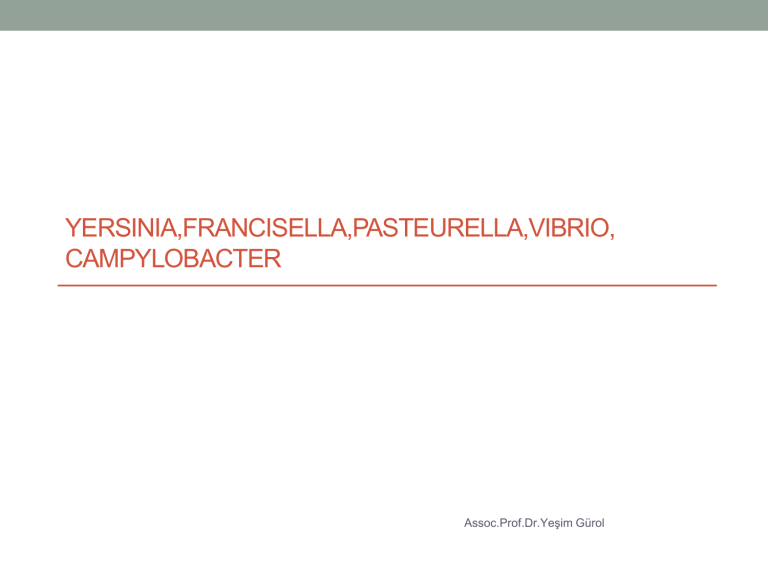
YERSINIA,FRANCISELLA,PASTEURELLA,VIBRIO,
CAMPYLOBACTER
Assoc.Prof.Dr.Yeşim Gürol
Yersinia Species
• members of the Enterobacteriaceae.
• short, pleomorphic Gram-negative rods or coccobacilli
• bipolar staining.
• Yersinia pestis is nonmotile. Other species are nonmotile at 98.6
°F (37°C) but motile at temperatures less than
86 °F (30°C) by means of peritrichous flagella.
• aerobic and facultatively anaerobic,
• oxidase-negative
• catalase-positive
• three important human pathogens zoonotic infections
• Y. pestis ........... plague
• Y. pseudotuberculosis and Y. enterocolitica
............infections known as yersiniosis.
Plague
• Flea bites . Plague bacteria are most often transmitted by the bite of an infected flea.
• Contact with contaminated fluid or tissue . Humans can become infected when handling tissue or body fluids of a plague-infected animal.
• Infectious droplets . When a person has plague pneumonia, they may cough droplets containing the plague bacteria into air.
Diagnosis
•
•
•
•
•
Lymph node aspirate : An affected bubo should contain numerous organisms that can be evaluated microscopically and by culture.
• Blood cultures : Organisms may be seen in blood smears if the patient is septicemic. Blood smears taken from suspected bubonic plague patients early in the course of illness are usually negative for bacteria by microscopic examination but may be positive by culture.
•
Sputum: Culture is possible from sputum of very ill pneumonic patients; however, blood is usually culture-positive at this time as well.
• Bronchial/tracheal washing may be taken from suspected pneumonic plague patients; throat specimens are not ideal for isolation of plague since they often contain many other bacteria that can mask the presence of plague.
• •
In cases where live organisms are unculturable (such as postmortem), lymphoid, spleen, lung, and liver tissue or bone marrow samples may yield evidence of plague infection by direct detection methods such as direct fluorescent antibody (DFA) or PCR .
• If cultures yield negative results, and plague is still suspected, serologic testing is possible to confirm the diagnosis. One serum specimen should be taken as early in the illness as possible, followed by a convalescent sample 4-6 weeks or more after disease onset.
• Y. pestis may be identified microscopically by examination of Gram,
Wright, Giemsa, or Wayson's stained smears of peripheral blood, sputum, or lymph node specimen. Visualization of bipolar-staining, ovoid, Gram-negative organisms with a "safety pin" appearance permits a rapid presumptive diagnosis of plague.
YERSINIOSIS
• Yersinia enterocolitica is harbored in the gastrointestinal tract of a wide range of mammals, including rodents, cattle, sheep, pigs, cats and dogs.
Infected animals tend to become chronic carriers and excrete large numbers of bacilli, which can contaminate water and dairy products. Humans are infected by eating inadequately cooked meat (especially pork) or other food contaminated with Yersinia spp.
• Yersinia pseudotuberculosis infection is less commonly seen. The organism is harbored in the gastrointestinal tract of rodents, farm animals and birds. Human infections have been reported from all parts of the world but, as with Y. enterocolitica , it is more common in northern Europe than elsewhere.
Infection is generally seen in children and affects males more frequently than females. The majority of infections occur in the winter.
• Prevention of yersiniosis depends on good animal husbandry and careful slaughtering techniques to minimize contamination of meat with orofecal material. Meat should not be consumed raw and should not be stored at 39 °F (4°C) for prolonged periods before consumption. There is no effective vaccine.
• Material for culture will include stool specimens, blood, lymph nodes and food samples
FRANCISELLA
• Tularemia is a disease of animals and humans caused by the bacterium
Francisella tularensis. Rabbits, hares, and rodents are especially susceptible and often die in large numbers during outbreaks.
•
•
•
•
•
•
Humans can become infected through several routes, including:
• Tick and deer fly bites
•Skin contact with infected animals
•Ingestion of contaminated water
•Laboratory exposure
•Inhalation of contaminated dusts or aerosols
• In addition, humans could be exposed as a result of bioterrorism
• Francisella spp. are very small, faintly staining, pleomorphic Gram-negative, nonmotile and nonspore-forming coccobacilli. They are strictly aerobic, oxidase-negative and weakly catalase-positive. The organisms are surrounded by a thin, lipid-rich capsule
• Isolation of F. tularensis from clinical material is potentially hazardous and it is imperative that the laboratory is notified if tularemia is suspected so that appropriate containment precautions can be taken. Francisella tularensis is a category 3 pathogen and should only be knowingly handled at containment level 3 in a biologic safety cabinet by trained and experienced staff.
• Gloves, masks and goggles should be worn when skinning or eviscerating animals. Animals that look sick should be left intact. Game meat should be thoroughly cooked and fresh water that is possibly contaminated should not be drunk. Ticks should be promptly removed and chemical insect repellants may be used.
• A live attenuated vaccine (LVS) was used to immunize laboratory staff working with F. tularensis in the USA until recently
Pasteurella
• small, nonmotile, nonspore-forming Gram-negative bacteria that are coccoid, oval or rod-shaped. They often exhibit bipolar staining. They are aerobic and facultatively anaerobic. Most species are catalase-positive and oxidasepositive
• They are commensals or parasitic organisms in the upper respiratory tract and gastrointestinal tracts of many domestic and wild animals and birds.
• Pasteurella multocida is transmitted to humans by contact with infected animals. The most common source of infection is bites, scratches, or licks from cats or dogs .Respiratory tract infections in those handling animals may result from airborne transmission
• Samples should be cultured on blood agar plates at 37 °C for 24 hours. Pasteurella multocida grows as small, gray, nonhemolytic colonies, with a strong odor of indole. Gram-stained films reveal small
Gram-negative coccobacilli. The organisms often show bipolar staining in methylene blue preparations. The identity of the organism can be confirmed by a series of biochemical and serologic tests and serology.
VIBRIO CHOLERAE
• Gram-negative, comma-shaped rod belonging to the family
Vibrionaceae.
• natural habitat consists of fresh-water and salt-water environments.
• Based on differences in the composition of the major cell wall antigen
(O), 139 serotypes have been differentiated.
• V. cholerae, which belongs to either serogroup O1 or serogroup
O139, has been associated with epidemic cholera.
• V. cholerae serogroup O1 can be subdivided into El Tor and classic biotypes as well as the Ogawa, Inaba and Hikojima serotypes.
• Cholera is an acute diarrheal disease in which the fluid loss is responsible for all other clinical manifestations of the disease
• Cholera is difficult to eradicate from water and is likely to remain a serious threat to public health for some time.
Measures to prevent cholera include separating sewage and drinking water systems, disinfection of drinking water and food, hygiene measures (e.g. hand washing with soap), active case finding and effective case management with the use of oral rehydration.
• culture
V. parahaemolyticus
• causes watery diarrhea often with abdominal cramping, nausea, vomiting, fever and chills
• infected by eating raw or undercooked shellfish, particularly oysters. Less commonly, this organism can cause an infection in the skin when an open wound is exposed to warm seawater.
• culture
V. vulnificus
• disease in those who eat contaminated seafood or have an open wound that is exposed to seawater.
• Among healthy people, ingestion of V. vulnificus can cause vomiting, diarrhea, and abdominal pain.
• In immunocompromised persons , particularly those with chronic liver disease, V. vulnificus can infect the bloodstream, causing a severe and life-threatening illness characterized by fever and chills, decreased blood pressure (septic shock), and blistering skin lesions.
• Culture
• Blood culture
Campylobacter spp
• microaerophilic, Gram-negative, curved rods
• adapted to life in mucus of the digestive tract
• Campylobacter jejuni and Campylobacter coli are responsible for enteric infections and are the most common Campylobacters found in humans.
• Campylobacter fetus is the third most frequently isolated, but is mostly involved in systemic diseases.
• The other species (e.g. Campylobacter lari , Campylobacter upsaliensis ) occur
• infections can be considered as zoonoses , because the primary reservoir f.or Campylobacter spp. is animals
• Preventive measures for Campylobacter spp. Infections
• heating of contaminated food and reinforcement of hygiene in the kitchen disinfection of drinking water supplies.
• eradication of the animal reservoir is extremely difficult
• development of vaccines is an alternative but no vaccine against campylobacteriosis is currently available
• The curved motile rods can be observed in a fecal sample using Gram staining or darkfield microscopy
• cultures are only incubated at 42 °C.
• selective culture media
• positive oxidase and catalase tests.
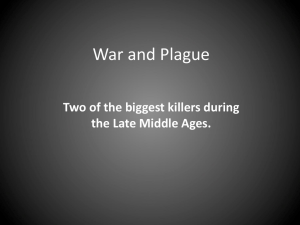



![[Presentation by Sara Morgans].](http://s2.studylib.net/store/data/005578977_1-95120715b429730785aca2fdba9a2208-300x300.png)



